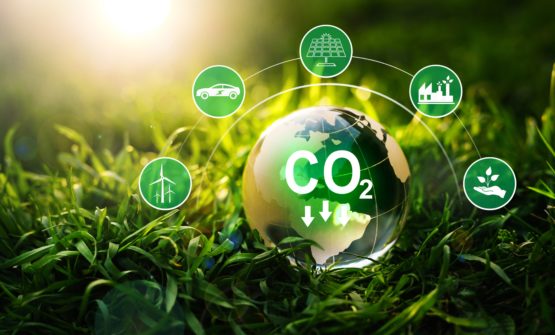Carbon dioxide equivalent or CO2e is a term used to describe the global warming potential of greenhouse gases. The carbon dioxide equivalent of a gas is calculated by multiplying the metric tons of CO2 emissions with the same global warming potential as the gas in question. For example, methane has a global warming potential of 21, so one metric ton of methane emissions is equal to 21 metric tons of carbon dioxide emissions. This number can then be used to compare the relative impact of different greenhouse gases.
CO2 vs. CO2e
What is the difference between CO2 and CO2e? CO2 refers to carbon dioxide emissions, while CO2e includes all other greenhouse gases. Greenhouse gases are measured in carbon dioxide equivalents because they have different global warming potentials. CO2e is a tool for comparing the relative impact of different greenhouse gases, while CO2 is carbon dioxide itself.
Global Warming Potential
Global Warming Potential is a number that represents the relative contribution of a gas to global warming. For carbon dioxide, the global warming potential is 1. This means that over a 100-year time frame, carbon dioxide emissions will have 1 unit of impact on climate change. So, if we emitted 1000 metric tons of carbon dioxide today, in 100 years time that would have the same impact as emitting 1000 metric tons of carbon dioxide today.
Carbon Offsets & CO2e

Carbon offsets are a type of carbon pricing strategy in which businesses or individuals purchase carbon credits to offset their carbon emissions. Carbon credits are a unit of measurement that represents the reduction of one metric ton of carbon dioxide equivalent gas. businesses or individuals can use carbon credits to offset their own emissions.
How are carbon offsets calculated?
Carbon offsets are calculated by multiplying the metric tons of CO2e emissions with the same global warming potential as the offset. For example, if one carbon offset equals one metric ton of carbon dioxide emissions, then the carbon offset would be calculated by multiplying the metric tons of carbon dioxide emissions by the global warming potential of carbon dioxide.
Carbon Offset Programs
There are many carbon offset programs available, and the price of carbon credits varies depending on the specific program. For example, the price of a carbon credit under the Kyoto Protocol‘s Clean Development Mechanism was about $7 per metric ton in 2008. The price of carbon credits has risen and fallen over time, but carbon offsets can be a useful way for businesses and individuals to offset their carbon emissions.
When choosing a carbon offset program, it is important to consider the specific project that your carbon credits will support. Make sure that the project meets environmental and social standards, and that it is verified by an independent third party. Also, consider the carbon offset program’s policies on carbon credits and how they will be used. Some programs allow businesses or individuals to purchase carbon credits that can be used to offset their own emissions, while others require that carbon credits be retired and not used again.
Voluntary Carbon Offsets
Voluntary carbon offsets are carbon credits that businesses or individuals purchase to offset their carbon emissions, but are not required to do so. Voluntary carbon offsets can be used to offset carbon dioxide emissions from any source, including personal travel, energy use, and business operations. There are many voluntary carbon offset programs available, and the price of carbon credits varies depending on the specific program.
Carbon Emissions & CO2e
Carbon offsets can be a useful way to offset your carbon emissions, but it is also important to reduce your emissions in the first place. There are many ways to reduce carbon emissions, and the most effective approach will vary depending on your individual circumstances.
Greenhouse Gases
Greenhouse gases are a major part of CO2e. They include carbon dioxide, methane, nitrous oxide, and water vapor. Greenhouse gases trap heat in the atmosphere and contribute to the greenhouse effect.
The greenhouse effect is a natural process that helps regulate the Earth’s temperature. Without it, the Earth would be too cold to support life. However, human activity has increased the levels of greenhouse gases in the atmosphere, and this is causing the Earth’s temperature to rise. This is known as global warming.
Global Warming
Global warming is a major threat to the environment and human health. It is causing the Earth’s climate to change, and this could lead to more extreme weather conditions, rising sea levels, and other impacts. To prevent these impacts, we need to reduce our carbon emissions and stop global warming.
Carbon Footprint

Your carbon footprint is the total amount of carbon dioxide and other greenhouse gases that you emit. It includes emissions from your car, home, and everyday activities. The average carbon footprint varies by country and region, but the average global carbon footprint is about 6 metric tons per person annually.
You can calculate your carbon footprint using carbon footprint calculators. These calculators will ask you questions about your energy use, transportation, and other activities. Once you have answered these questions, the calculator will estimate your carbon footprint. Then, your carbon footprint can then be offset with CO2e carbon credits.
Carbon Neutrality & CO2e
Carbon neutrality means having a carbon footprint of zero. This can be achieved by reducing your emissions as much as possible and offsetting the remaining emissions with carbon credits. Carbon neutrality is important because it helps to stop global warming and protect the environment.
When a business or individual achieves carbon neutrality, they are typically recognized with a carbon neutral label. This label shows that the business or individual has taken steps to offset their carbon emissions and is working to reduce their impact on the environment.
Why be carbon neutral?
The major question many ask is why be carbon neutral? There are many reasons to work towards carbon neutrality. As mentioned before, carbon neutrality can be an effective tool to help and protect the environment from climate change. Additionally, it can help businesses and individuals save money. Reducing emissions can save businesses money on energy costs, and offsetting emissions can be less expensive than other carbon reduction strategies. Carbon neutrality can also help businesses and individuals market themselves as environmentally-friendly and sustainable.

